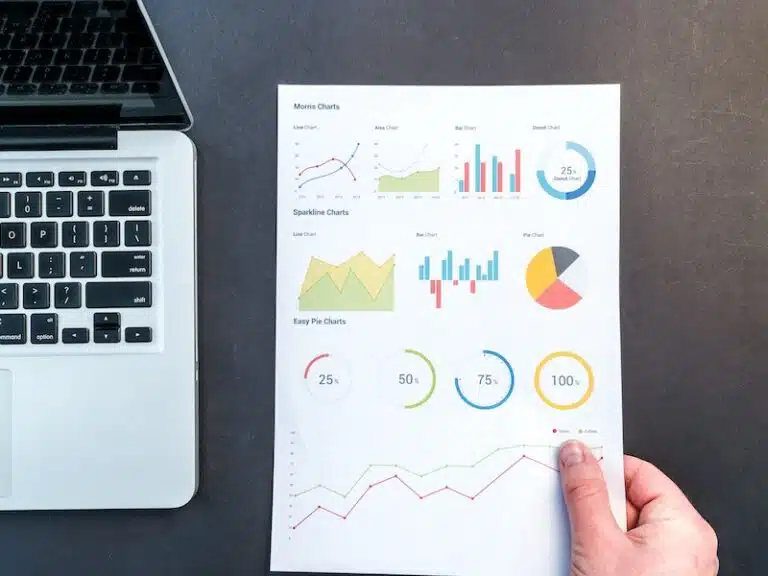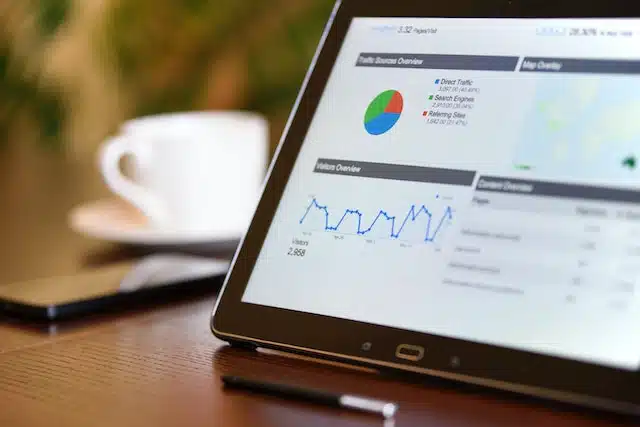You spend a lot of time and effort running your business. From ensuring your sales funnels bring in leads to checking the finances. While attending to different areas of your company, keeping track of business objectives and overall performance can be challenging.
Key performance indicators can be a great way to measure progress within your business and understand how well you are achieving specific objectives. KPIs can also help improve employee satisfaction by providing clear goals and measurable outcomes. We will look closer at the benefits of using KPIs in this post.

What Are Key Performance Indicators?
Let’s discuss what key performance indicators are and what they mean. You already know the importance of goal setting. Without setting goals for your business, it’s hard to understand how well the company performs.
You can set different goals for your business. Your goals may include achieving high customer satisfaction, for example. Sometimes, you may set specific goals for internal operations.
This may include employee performance or finishing a project within a specific timeframe. It’s essential to have measurable values that you can use to understand how your business performs.
Financial metrics, such as revenue growth and profitability, are crucial KPIs for evaluating a company’s financial health.
This is where a key performance indicator system comes into play.
These performance indicators are values that can determine the efficacy of a person, team, or entire organization. They can also be used to evaluate the efficacy and performance of a specific campaign.
KPIs are not always solely used in a business environment. Many professionals will also create a set of personal key performance indicators to measure their performance.
This is a good strategy for freelancers but can also be used by employees who want to evaluate their performance and how effectively they reach their goals.
Importance of KPIs
Key performance indicators (KPIs) are essential for businesses to measure progress, track performance, and make data-driven decisions. By setting and monitoring KPIs, organizations can align their teams with strategic goals, improve employee engagement, and drive growth. KPIs provide a quantifiable means of measuring progress and performance, empowering businesses to make informed decisions, allocate resources efficiently, and foster a culture of continuous improvement.
When businesses leverage key performance indicators, they gain a clearer understanding of their operational and strategic landscapes. This clarity allows for better resource allocation, ensuring that efforts are directed towards areas that will yield the most significant impact. Moreover, KPIs help in identifying trends and patterns, enabling proactive adjustments to strategies and operations. This proactive approach not only enhances performance but also positions the business to seize opportunities and mitigate risks effectively.
Different Types Of KPIs
The KPIs you use to measure business performance are not all the same. You should have a good understanding of the different KPIs that can be used, including both leading and lagging indicators, to create a balanced and effective measurement system.
This lets you fully set up a strategic plan to benefit from KPIs.
Here, we take a closer look at different types of KPIs that you should understand:
- Lagging: A lagging KPI refers to your business’s current state. These KPIs measure goals you set and want to reach within a specific timeframe. Lagging indicators help assess past performance over specific periods, such as sales results from the last month, which can inform future strategies and decisions.
- Leading: Measuring the future state of business goals and the organization is essential too. This is where leading KPIs come into the picture.
- High: When you want to use relevant KPIs for the entire business or organization, these are known as High KPIs.
- Low: Low KPIs are smaller performance indicators with a particular goal, such as measuring progress towards a small project your business has taken on.
Strategic vs. Operational KPIs
Strategic KPIs focus on high-level objectives, such as revenue growth, customer satisfaction, and market share. These KPIs are typically monitored by executives and senior management to ensure the organization is on track to meet its long-term goals. For instance, a strategic KPI might be to increase market share by 5% over the next year, reflecting the company’s broader vision and mission.
Operational KPIs, on the other hand, focus on day-to-day activities, such as sales volume, customer acquisition cost, and employee productivity. These KPIs are typically monitored by department managers to ensure efficient operations and process improvement. For example, an operational KPI might track the number of customer support tickets resolved within 24 hours, ensuring that daily operations run smoothly and efficiently.
By distinguishing between strategic and operational KPIs, businesses can ensure that both long-term objectives and daily activities are aligned and optimized for success.
What Benefits Do KPIs Offer for Strategic and Operational Improvement?

KPIs are indispensable for businesses seeking to harness data-driven insights for strategic advantage. They not only illuminate the path to enhanced operational efficiency and performance but also empower organizations to anticipate challenges and seize opportunities in real-time.
By providing a clear framework for measuring success against predefined objectives, KPIs enable businesses to pinpoint areas for improvement, drive employee engagement and accountability, and strategically navigate towards sustained growth and competitiveness. Leveraging KPIs means transforming raw data into actionable intelligence, setting the stage for informed decision-making and strategic agility.
KPIs can be used to set specific goals and track progress, ultimately helping to improve performance across various departments.
Analyzing KPIs can offer numerous benefits for your business. Understanding the vital role that KPIs can play in your business will help you know why you should consider implementing them.
We will take a closer look at the most important ways that KPIs can benefit your business.
Better Communication With Your Employees
Employees are driven by the goals that you set for them. If they don’t have specific business goals to strive toward, it’s harder for them to do their jobs.
You can use trackable KPIs to communicate better with your employees.
This may include setting a specific goal regarding how much time your employees have to respond to a lead or how many sales emails they must send out daily.
You could also set a number of sales calls your employees should strive to achieve daily or weekly.
Two benefits come into play in this situation.
First, your employees know what you expect of them. This can drastically boost morale and performance.
Secondly, it gives you the ability to measure performance among employees. You’ll be able to identify an underperforming employee and see who works most accurately toward the goals you set for them.
Better Understanding Of Project Performance
Your business processes often include the implementation of projects.
This could be projects for clients. In some cases, the projects may be related to internal factors, such as the projects your marketing team works on to enhance the brand’s visibility.
Regardless of the project that your teams work on, there are specific goals that they need to strive toward. Whether to close a certain number of sales or to bring in 100 leads per day, use trackable KPIs in these instances.
Your KPI dashboard can help you see valuable information regarding these projects. You set KPIs you expect employees to achieve and then track them on the dashboard. You can then use this data to determine whether your goals are realistic.
Additionally, the KPIs also help to ensure your team performs the tasks you assigned to them – and help you determine areas where there is a noticeable underperformance.
Identify The Need For Training
Team members in your organization are only able to perform tasks that they have the skills for. If they lack specific skills or are not contempt of the latest changes in the industry, they cannot make informed decisions. Whether they work on sales or customer satisfaction, there are important ways to measure KPIs and identify training needs.
This can lead to poor performance within your company – and possibly even cost you money, especially in the long run.
To improve progress in such a scenario, you’ll need to identify the need for further employee training. This is where KPIs provide benefits for your business. KPIs drive strategic and operational improvement by identifying training needs and areas for skill development.
While there is not a single KPI that can indicate this particular requirement, you can analyze the indicators you have at your disposal to detect patterns that indicate problems with current performance.
One example would be setting KPIs to increase your sales by a certain percentage within the upcoming quarter.
When you reach the end of the period, you do not see the expected results. This could be an excellent way to identify further sales training needs.
You can then further use tangible KPIs to help you get an overview of how effective the training is. The KPIs help you compare performance before and after training.
Improves Employee Engagement
KPIs can significantly improve employee engagement by providing a sense of purpose and direction. When employees have clear goals and objectives, they understand how their work contributes to the organization’s overall success. This understanding leads to increased motivation, productivity, and job satisfaction.
Moreover, KPIs help employees track their progress, identify areas for improvement, and develop a sense of ownership and accountability. When employees see how their efforts directly impact key performance indicators, they are more likely to feel valued and motivated to perform at their best. This sense of ownership fosters a positive work environment where employees are engaged and committed to achieving the organization’s strategic goals.
Are There Any Disadvantages To KPIs?
There certainly are numerous benefits that you can expect from setting the right KPIs for your business.
It helps you understand the projects completed, employee performance, and how well your company reaches its goals.
While these are all great, there are two things to remember when taking advantage of KPIs. These aren’t necessarily disadvantages but are still important factors when utilizing KPIs.
- The time spent to create, collect and analyze KPIs can be long. You cannot expect to implement KPIs in your business and get results in just a short period. It takes some time for KPIs to provide the data you need to benefit from them and draw conclusions effectively.
- If you’re very new to KPIs, it can also take some time for you to learn how to use them effectively. The learning curve can feel tedious for some people, but if you push through, you will get noticeable improvements in your business.
How Do I Create KPIs For My Business?
When you start with KPIs in your business, it’s important not to overwhelm yourself. Focus on one thing at a time, such as sales, customer satisfaction, or performance measurement in your marketing department.

It may be tempting to set up multiple KPIs, but this can quickly become confusing. Begin with the basics, and then move on from there.
Make sure you also know what a good KPI looks like. A good KPI should ideally make use of the SMART framework:
- Specific
- Measurable
- Achievable
- Realistic
- Timely
When your KPIs take advantage of the framework, it’s easier to ensure you set the right indicators that won’t make it challenging to track your results later on.
Here are a few steps that you should take to set up KPIs that are trackable, realistic, and appropriate for your situation:
- Start with the end goal in mind. Before you can set a KPI, you need to know what you expect. If you don’t have an end goal, you might waste time, effort, and money in the process. Set a realistic goal and determine the timeline. This could be increasing sales by 10% within the next three months.
- The next step is where key performance questions come into play. You can ask these questions to determine whether you have reached the specific goal. Open-ended questions are usually best here. Examples of questions include “How does my sales team affect the results of the goal” or “Why is the specific goal important.”
- You now need to look at the existing data that you have already accumulated. This particular step can be a bit time-consuming, but having some data is always useful. While you can look at the KPIs used by industry competitors, make sure you also understand the unique points of your business. The data you collect highly depends on the goals that you want to strive for.
- You should determine a performance analysis schedule. This relates to how frequently you will draw up reports to evaluate your business’s progress based on the study of these KPIs.
- Make sure you break down the end goal into smaller achievements. You’ll have an easier time working toward smaller goals, and it will bring about a sense of achievement. Smaller goals also make it easier to understand how well you are doing in terms of the bigger goal that you are striving for. If your end goal is to make a $120,000 profit within a 12-month period, then break this down to a goal of $10,000 per month.
- Once you have everything ready, it’s time to determine who will be involved in the process. Delegate tasks and responsibilities amongst various departments and teams – and ensure they know the end goal.
Setting SMART KPIs
To set effective KPIs, organizations should follow the SMART framework:
- Specific: Clearly define what you want to measure and achieve.
- Measurable: Quantify the KPI to track progress and performance.
- Attainable: Ensure the KPI is realistic and achievable.
- Relevant: Align the KPI with strategic goals and objectives.
- Time-bound: Establish a specific timeframe for achieving the KPI.
By setting SMART KPIs, organizations can ensure that their goals are clear, achievable, and aligned with their overall strategy. This framework helps in creating KPIs that are not only easy to track but also meaningful and impactful. For example, instead of setting a vague goal like “improve sales,” a SMART KPI would be “increase sales by 10% in the next quarter,” providing a clear target and timeline.
Best Tools To Help You Understand Your KPI Dashboards

Keeping track of everything manually can be time-consuming and wastes effort. This is why you might want to look at ways to have data update automatically and reduce the amount of manual effort required. While you’ll still need to set your own KPIs, you can use certain tools to ease and automate the reporting process. KPI dashboards are essential tools for visualizing and analyzing key performance indicators across various business units. They provide real-time data, enabling quick assessments of performance and facilitating informed decision-making through easily digestible visual elements.
Here are a couple of tools that offer an excellent solution for keeping track of your KPIs:
- Spinify is an AI-powered sales gamification platform designed to enhance team performance by integrating gamification elements into KPI tracking. It offers customizable, gamified competitions that align with your business objectives, allowing you to monitor essential metrics seamlessly across all devices. By fostering healthy competition and recognizing individual achievements through badges and personalized videos, Spinify boosts engagement and motivation among team members. Its seamless integration with existing platforms simplifies the gamification process, making it an effective tool for understanding and improving your KPI dashboards.

- SAS Visual Analytics comes with a dashboard and deploys on the cloud. There are also mobile apps to help you keep track on the go.
- NetSuite offers an advanced system that is available on both desktop and mobile. You get benchmarking and key performance indicators with this system.
- Zoho Analytics is also a great tool to consider. It keeps track of everything from team lunches to the performance measurement of projects.
You can also use more comprehensive tools and systems to help you view your KPIs and performance on an annual, weekly, and monthly basis. One example is sales gamification software, which makes participating in some friendly competition fun for your team.
It’s a great way to keep everyone motivated and ensure you have KPIs you can refer to whenever you need to. Some general business management software options will also help you keep track of essential data and measurable metrics in your KPI strategy.
KPI Reports and Dashboards
KPI reports and dashboards are essential tools for tracking and analyzing performance. A KPI report provides a comprehensive document that presents key performance indicators in a clear and structured manner, including charts, graphs, and written analysis. This detailed approach helps in understanding the nuances of performance metrics and making informed decisions.
A KPI dashboard, on the other hand, offers a visually engaging display of progress, providing real-time or near-real-time data on performance. Dashboards are particularly useful for quick insights and immediate action, allowing managers to monitor key metrics at a glance.
By using KPI reports and dashboards, organizations can:
- Improve employee engagement and morale
- Close learning gaps
- Measure performance
- Help make decisions
- Detect patterns over time
- Set and track specific goals
In conclusion, KPIs are a crucial component of any business strategy, providing a quantifiable means of measuring progress and performance. By setting SMART KPIs, organizations can align their teams with strategic goals, improve employee engagement, and drive growth. KPI reports and dashboards are essential tools for tracking and analyzing performance, helping organizations make data-driven decisions and achieve sustainable success.
Spinify can help
Key performance indicators are a great way to understand the performance of your business. You can use these key performance indicators to evaluate a specific employee, a team, or even your business as a whole.
At Spinify, we help businesses reach their goals through gamification. The use of gamification, along with strategic goals, can boost performance and engagement among your internal teams. Book a demo today to learn how Spinify’s gamification software can help you get better results when analyzing your key performance indicators.




